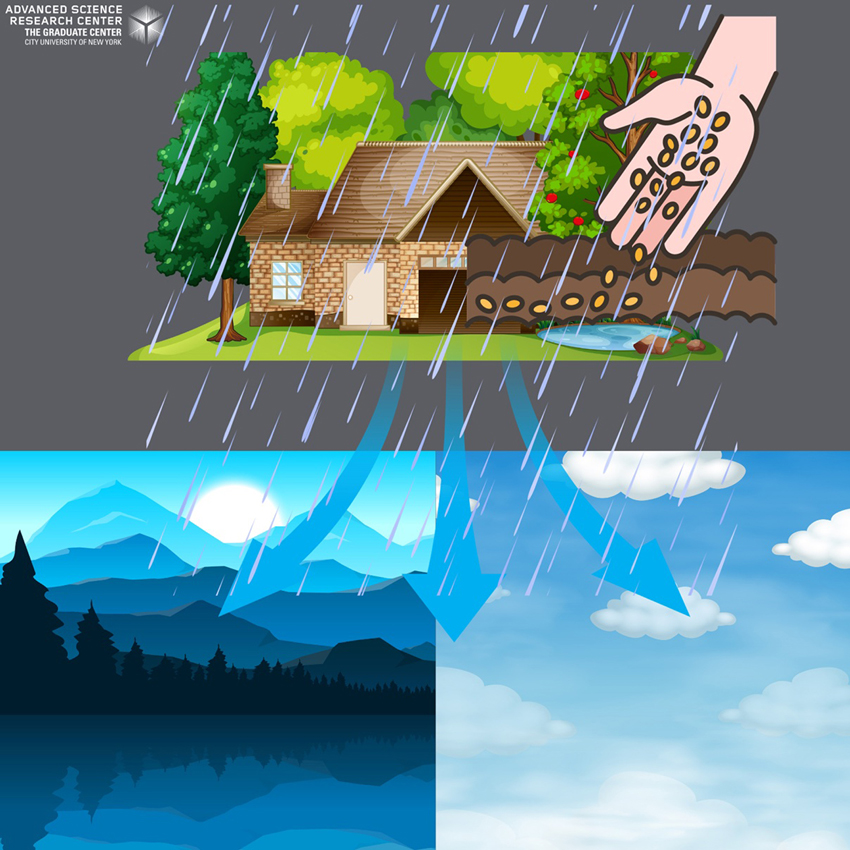Posted on October 17, 2023 in ASRC News, Environmental Sciences Initiative

A new study finds that fertilized lawns are hotspots of nitrogen export into our water and atmosphere.
NEW YORK, October 17, 2023 — The American residential lawn is, for many, an iconic landscape, and about half of homeowners in the US use fertilizer to keep their yards green and lush. But those hallmarks of ostensive health hide a growing environmental health problem, which is caused when the nitrogen in fertilizers washes downstream or escapes into the atmosphere. In a newly published paper in the journal Proceedings of the National Academy of Sciences (PNAS) NEXUS, researcher Peter Groffman and his colleagues studied residential landscapes in the Baltimore, Maryland metropolitan area, which drains to the Chesapeake Bay, seeking to identify locations (hotspots) or times (hot moments) with disproportionately high rates of nitrogen export.
“We found that these fertilizers applied to particular places at particular times are more likely to move into receiving waters where they can have deleterious consequences, including spawning algal blooms and deoxygenated waters,” said Groffman, an environmental sciences professor with the Advanced Science Research Center at the CUNY Graduate Center and Brooklyn College. “This information can be very useful in helping individual residents and municipalities adjust lawn care practices that are harming our environment and ultimately our health.”
For their study, the authors went to lawns in Baltimore’s exurban, suburban, and college campus settings to measure nitrogen export to water and air during simulated rainfall events, which are created by adding known amounts of water to lawns in the field. They also used household survey data collected by the Baltimore Ecosystem Study Long Term Ecological Research in 2003, 2011, and 2018—as well as their own push-to-web survey of 3,836 Baltimore area households about lawn fertilization practices. Their analysis of the lawns’ nitrogen export dynamics showed tremendous variation, but all the export hotspots were found on fertilized rather than unfertilized lawns.

The study also found that 48% of the 2018 survey respondents incorrectly believed that they did not live in a watershed, and more than 60% of web survey respondents did not know that nitrogen negatively affects area waterways. In light of this knowledge, support for policies limiting fertilizer use was broadly high among surveyed households, with some types of restrictions even garnering support among those who fertilize their lawns. About half of households are interested in converting lawns to features that reduce nitrogen export, such as rain gardens, if such conversions are subsidized and made as easy as possible. According to the authors, changing just 5-10% of suburban lawns to alternative landscaping might have a major effect on watershed-wide nitrogen export.
“Hydro-bio-geo-socio-chemical interactions and the sustainability of residential landscapes,” by Peter M. Groffman, Amanda K. Suchy, Dexter H. Locke, Robert J. Johnston, David A. Newburn, Arthur J. Gold, Lawrence E. Band, Jonathan Duncan, J. Morgan Grove, Jenny Kao-Kniffin, Hallee Meltzer, Tom Ndebele, Jarlath O’Neil-Dunne, Colin Polsky, Grant L. Thompson, Haoluan Wang, and Ewa Zawojska.
About the Advanced Science Research Center at the CUNY Graduate Center
The Advanced Science Research Center at the CUNY Graduate Center (CUNY ASRC) is a world-leading center of scientific excellence that elevates STEM inquiry and education at CUNY and beyond. The CUNY ASRC’s research initiatives span five distinctive, but broadly interconnected disciplines: nanoscience, photonics, neuroscience, structural biology, and environmental sciences. The center promotes a collaborative, interdisciplinary research culture where renowned and emerging scientists advance their discoveries using state-of-the-art equipment and cutting-edge core facilities.
